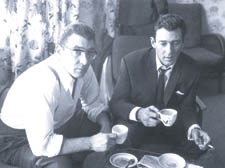|
|
 |
| |

Ron and Reg Kray relax with a cup of tea at home after being questioned by police over the death of rival gang member George Cornell |
Murder most foul among East Enders
From Jack the Ripper to Ronnie Kray, Neil R Storey’s macabre history of brutal killings and gang war reveals a darker side of the capital, writes Peter Gruner
East End Murders from Jack the Ripper to Ronnie Kray.
By Neil R Storey.
History Press £12.99
COR blimey, murderous events on the streets of the East End? Sounds like perfect Christmas reading.
East End Murders from Jack the Ripper to Ronnie Kray is just what you need to take your mind off the tortured and bloody economic downturn and the death of jobs.
Neil R Storey’s True Crime History begins with Henry Wainwright, 1875, and a chapter called The Businessman, the Actress and the Dismembered Mistress. Then on to Jack the Ripper, 1888, and The Autumn of Terror; right up to 1966, Ronald Kray and Murder at the Blind Beggar.
With accounts of the Ratcliffe Highway murders of 1811, the axe murder at the Regal Palace Bow in 1934, and the Siege of Sidney Street, 1909, there’s something for everyone’s, er, taste.
Indeed, Mr Storey is no slouch when it comes to research. He has drawn on a vast array of original sources, among them witness statements, coroners’ reports and court records, to produce a revealing insight into the East End’s darkest moments.
Henry Wainwright, who had a shop in Whitechapel, was a successful businessman, teetotaller, church warden, and apparently happily married with four children. A thoroughly decent cove according to all accounts.
But that didn’t stop him leading a double life with a milliner called Harriet Lane. He secretly married her and moved her into a love nest in St Peter’s Street, Mile End.
She bore him two children and began to demand more money for housekeeping.
Wainwright’s debts increased and Harriet threatened to expose their affair to his wife.
Wainwright subsequently battered Harriet with a hammer and shot her three times. Her remains were buried in Henry’s warehouse.
Just when Henry thought he was getting away with it – and with his new friend, chorus girl Alice Dash – he was arrested by the police. The odour of Harriet’s decaying corpse had been, as they say, a dead giveaway.
He was executed by hanging on December 12 1875. Moments before the end he smoked a cigar. His last words to those who had come to witness the execution were: “Come to see a man die, have you, you curs!”
Lovely boys the Kray twins. Doted on their dear old mum and called her “our Queen”.
Both highly successful businessmen who attracted a host of stars such as Diana Dors, Barbara Windsor and Freddie Mills, the boys were respected across the East End. In fact, people said they felt safer when the Krays were around.
But the Krays built their empire with a vast protection racket. Any trouble in pubs or snooker halls and the boys would “sort it out” – for a fee of about £5 a night. Anyone who refused could find gangs turning up at their pub to attack them and their customers with coshes and razors.
The twins were also fighting a feud with another gang, the Richardsons, from south London.
On March 9, 1966, one of the Richardson hard men, George Cornell, was drinking in the Krays’ “manor” at the Blind Beggar pub in Mile End Road.
Cornell had verbally insulted Ronnie previously and the twin was determined to settle a major score between the two.
Mr Storey writes: “Accounts vary between 12 and 30 people being in the pub. At the time one man I knew personally said he was drinking in the pub and was urged ‘by a friend’ not to be around – no names were mentioned but he left in no doubt ‘something was going to happen’.”
Something did happen. Ronnie entered the pub and, without saying a word, drew his 9mm Mauser automatic pistol and shot Cornell dead.
The jukebox, which had been playing the Walker Brothers’ hit The Sun Ain’t Gonna Shine Anymore, was stuck on the words: “Anymore...Anymore... Anymore.”
With no one to give evidence, the police had a long slog to convict the Krays of anything.
But they were arrested on May 9, 1968, and once they were detained witnesses slowly started to develop the confidence to give evidence.
The trial lasted 39 days at the Old Bailey and the twins were sentenced to life imprisonment. |
| |
|
 |
 |
|
 |
|


